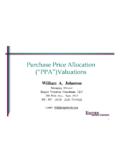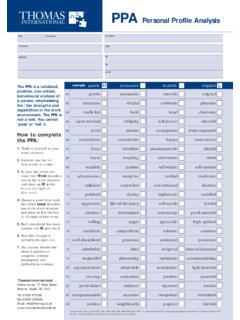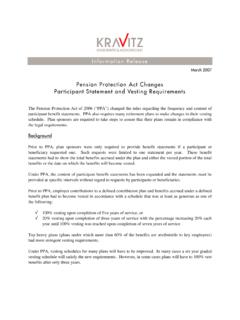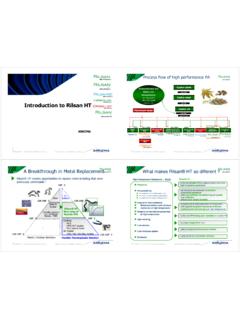Transcription of What is PPA?
1 what is PPA? primary progressive aphasia (PPA) is a form of cognitive impairment that involves a progressive loss of language function. Language is a uniquely human faculty that allows us to communicate with each other through the use of words. Our language functions include speaking, understanding what others are saying, repeating things we have heard, naming common objects, reading and writing. aphasia is a general term used to refer to deficits in language functions. PPA is caused by degeneration in the parts of the brain that are responsible for speech and language.
2 PPA begins very gradually and initially is experienced as difficulty thinking of common words while speaking or writing. PPA progressively worsens to the point where verbal communication by any means is very difficult. The ability to understand what others are saying or what is being read also declines. In the early stages, memory, reasoning and visual perception are not affected by the disease and so individuals with PPA are able to function normally in many routine daily living activities despite the aphasia . However, as the illness progresses, other mental abilities also decline.
3 Adults of any age can develop PPA, but it is more common in people under the age of 65. People with PPA can have a variety of different language symptoms and no two cases are exactly the same. Symptoms & Causes SYMPTOMS People with PPA can experience many different types of language symptoms. In many instances, the person with PPA may be the first to note that something is wrong and the complaints may initially be attributed to stress or anxiety. People with PPA initially experience one or more of the following symptoms: Slowed or halting speech Decreased use of language Word-finding hesitations Sentences with abnormal word order in speech or e-mails Substitution of words ( , table instead of chair ) Using words that are mispronounced or incomprehensible ( , track for truck ) Talking around a word ( , "We went to the place where you can get bread" for the words grocery store )
4 Difficulty understanding or following conversation despite normal hearing Sudden lapse in understanding simple words Forgetting the names of familiar objects Inability to think of names of people, even though the person is recognized Problems writing ( difficulty writing checks or notes) Problems reading ( difficulty following written directions or reading signs) New impairments in spelling Problems in arithmetic and calculations ( making change, leaving a tip) People with PPA tend to have similar clusters of symptoms. Researchers who specialize in PPA currently recognize three subtypes: agrammatic, logopenic and semantic.
5 >>>PPA-G (Agrammatic/Nonfluent Subtype): A problem with word-order and word-production Speech is effortful and reduced in quantity. Sentences become gradually shorter and word-finding hesitations become more frequent, occasionally giving the impression of stammering or stuttering. Pronouns, conjunctions and articles are lost first. Word order may be abnormal, especially in writing or e-mails. Words may be mispronounced or used in the reverse sense ( , he for she or yes for no ). Word understanding is preserved but sentence comprehension may suffer if the sentences are long and grammatically complex.
6 >>>PPA-L (Logopenic Subtype): A problem with word-finding In contrast to PPA-G, speech is fluent during causal small talk but breaks into mispronunciations and word-finding pauses when a more difficult or precise word needs to be used. Some people with PPA-L are very good at going around the word they cannot find. They learn to use a less apt or simpler word as well as to insert fillers such as the thing that you use for it, you know what I mean, or whatchamacallit . Spelling errors are common. The naming of objects becomes impaired.
7 Understanding long and complex sentences can become challenging but the comprehension of single words is preserved. >>>PPA-S (Semantic Subtype): A problem with word-understanding The principal feature is a loss of word meaning, even of common words. When asked to bring an orange, for example, the person may appear puzzled and may ask what an orange means. Speech has very few nouns and is therefore somewhat empty of meaning. However, it sounds perfectly fluent because of the liberal use of fillers. The person may seem to have forgotten the names of familiar objects.
8 CAUSES PPA arises when nerve cells in language-related parts of the brain malfunction. The underlying diseases are called degenerative because they cause gradually progressive nerve cell death that cannot be attributed to other causes such as head trauma, infection, stroke or cancer. There are several types of neurodegeneration that can cause PPA. The two most commonly encountered types are frontotemporal lobar degeneration (FTLD) and Alzheimer s disease (AD). Both FTLD and AD can lead to many different patterns of clinical impairments, depending on the region of the brain that bears the brunt of the nerve cell loss.
9 When AD or FTLD attacks the language areas (usually on the left side of the brain), PPA results. PPA is caused by AD in approximately 30-40% of cases and by FTLD in approximately 60-70% of cases. In contrast, PPA is a very rare manifestation of AD. In the vast majority of patients with AD, the most prominent clinical symptom is a memory loss for recent events (amnesia) rather than an impairment of language ( aphasia ). PPA is therefore said to be an atypical consequence of AD. The logopenic type of PPA has a particularly high probability of being caused by AD.
10 Specialized positron emission tomography (PET) scans and examination of the spinal fluid may help to resolve the distinction between the two underlying diseases. Whether or not PPA is caused by AD or FTLD can be determined definitively only at autopsy through examination of brain tissue with a microscope. This can be confusing because for reasons outlined in the previous paragraph, the word Alzheimer s can be used in two different ways. The term Alzheimer s dementia (or Dementia of the Alzheimer-Type) is used to designate a progressive loss of memory leading to a more generalized loss of all cognitive functions.





